Customer Motivation to Order Healthy and Fresh Food in Restaurants
VerifiedAdded on 2023/01/19
|15
|4070
|46
Report
AI Summary
This research report investigates the factors that motivate customers to order healthy and fresh food in restaurants. Conducted using social grounded theory and non-participant observation, the study analyzed customer behavior across different eating sessions (breakfast, lunch, and dinner) in a specific restaurant. The research identified significant patterns related to age, sex, culture, food promotions, and time of day in relation to food consumption. The report concludes that various underlying factors influence customers' choices of healthy and fresh foods, with limitations including potential disruptions from restaurant management and the inability to directly engage with customers to understand their thought processes fully. The methodology involved observing customer behaviors, reactions, and conversations, using tools like cameras and audio recorders to collect data. The analysis revealed that factors such as age, gender, and promotional activities significantly influence food choices, with younger customers often preferring less healthy options compared to older individuals. The study provides valuable insights into customer preferences and motivations for healthy eating in a restaurant environment.
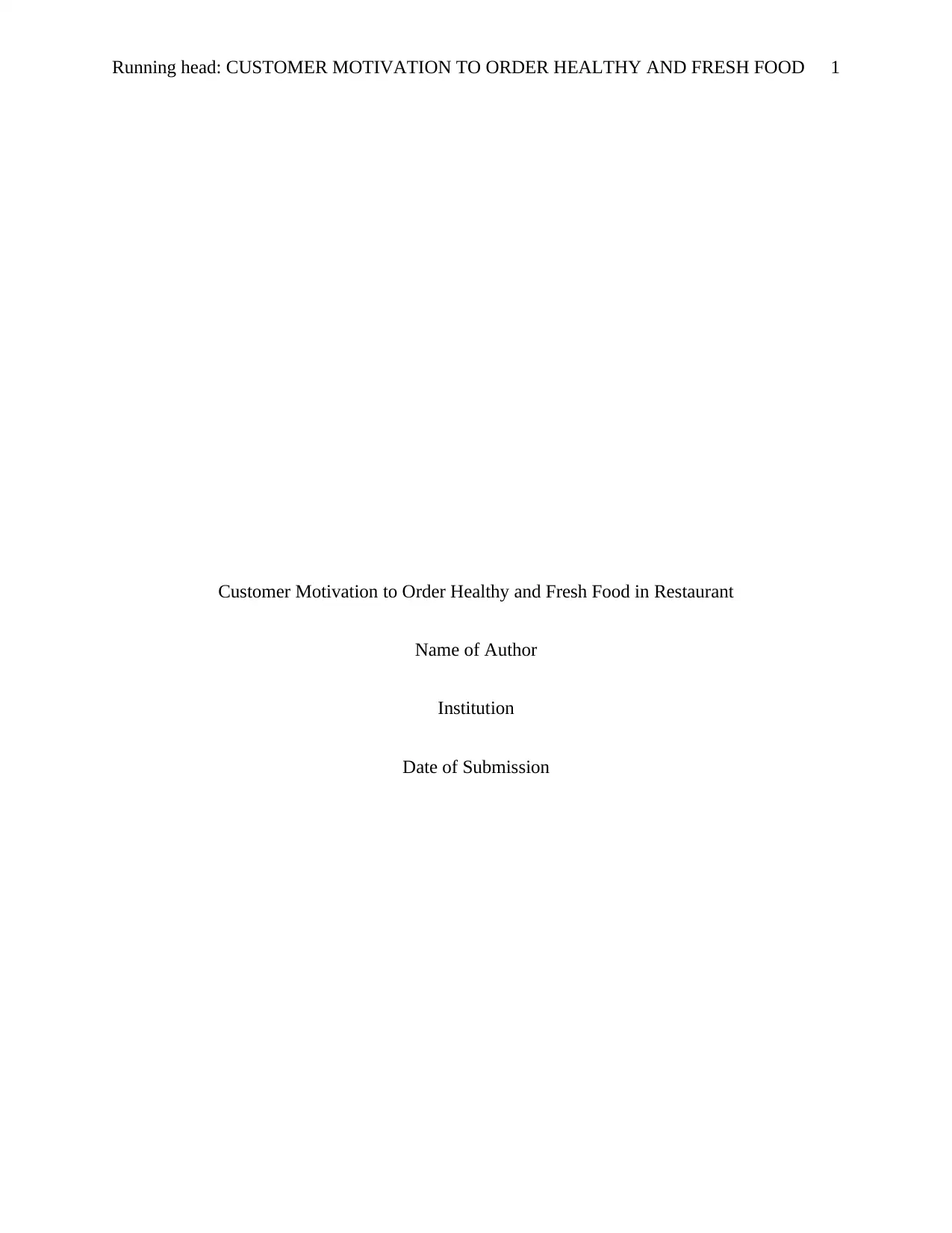
Running head: CUSTOMER MOTIVATION TO ORDER HEALTHY AND FRESH FOOD 1
Customer Motivation to Order Healthy and Fresh Food in Restaurant
Name of Author
Institution
Date of Submission
Customer Motivation to Order Healthy and Fresh Food in Restaurant
Name of Author
Institution
Date of Submission
Paraphrase This Document
Need a fresh take? Get an instant paraphrase of this document with our AI Paraphraser
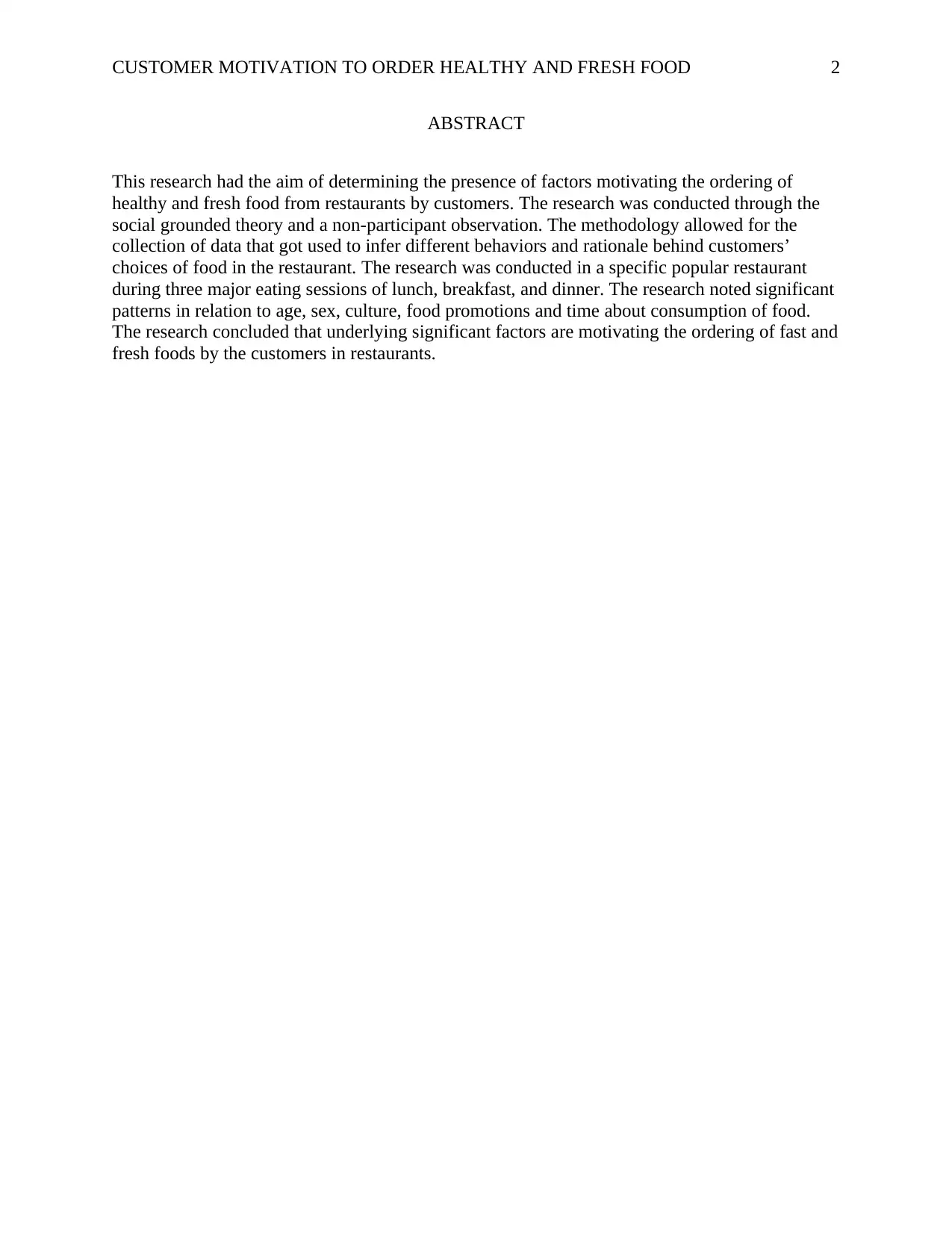
CUSTOMER MOTIVATION TO ORDER HEALTHY AND FRESH FOOD 2
ABSTRACT
This research had the aim of determining the presence of factors motivating the ordering of
healthy and fresh food from restaurants by customers. The research was conducted through the
social grounded theory and a non-participant observation. The methodology allowed for the
collection of data that got used to infer different behaviors and rationale behind customers’
choices of food in the restaurant. The research was conducted in a specific popular restaurant
during three major eating sessions of lunch, breakfast, and dinner. The research noted significant
patterns in relation to age, sex, culture, food promotions and time about consumption of food.
The research concluded that underlying significant factors are motivating the ordering of fast and
fresh foods by the customers in restaurants.
ABSTRACT
This research had the aim of determining the presence of factors motivating the ordering of
healthy and fresh food from restaurants by customers. The research was conducted through the
social grounded theory and a non-participant observation. The methodology allowed for the
collection of data that got used to infer different behaviors and rationale behind customers’
choices of food in the restaurant. The research was conducted in a specific popular restaurant
during three major eating sessions of lunch, breakfast, and dinner. The research noted significant
patterns in relation to age, sex, culture, food promotions and time about consumption of food.
The research concluded that underlying significant factors are motivating the ordering of fast and
fresh foods by the customers in restaurants.
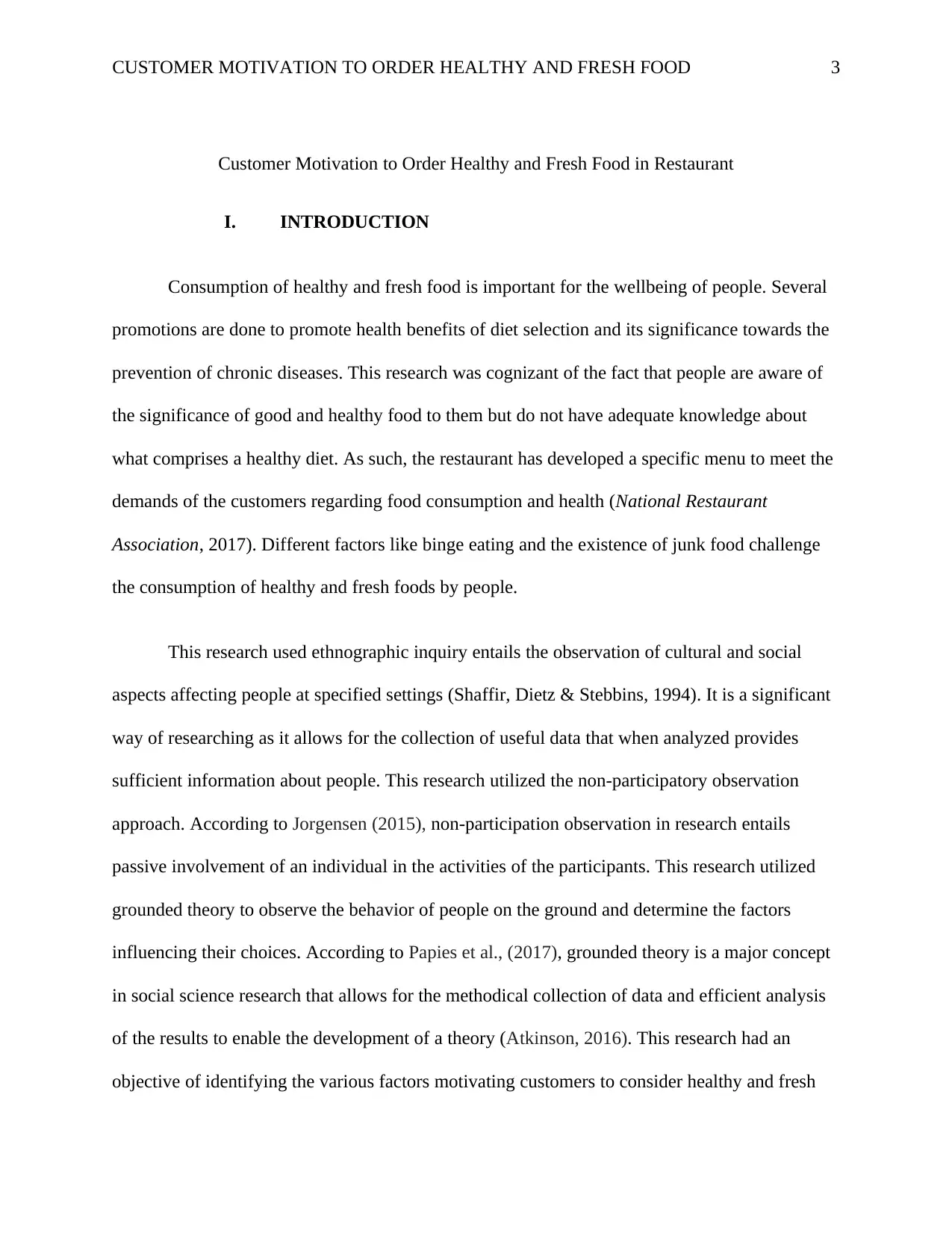
CUSTOMER MOTIVATION TO ORDER HEALTHY AND FRESH FOOD 3
Customer Motivation to Order Healthy and Fresh Food in Restaurant
I. INTRODUCTION
Consumption of healthy and fresh food is important for the wellbeing of people. Several
promotions are done to promote health benefits of diet selection and its significance towards the
prevention of chronic diseases. This research was cognizant of the fact that people are aware of
the significance of good and healthy food to them but do not have adequate knowledge about
what comprises a healthy diet. As such, the restaurant has developed a specific menu to meet the
demands of the customers regarding food consumption and health (National Restaurant
Association, 2017). Different factors like binge eating and the existence of junk food challenge
the consumption of healthy and fresh foods by people.
This research used ethnographic inquiry entails the observation of cultural and social
aspects affecting people at specified settings (Shaffir, Dietz & Stebbins, 1994). It is a significant
way of researching as it allows for the collection of useful data that when analyzed provides
sufficient information about people. This research utilized the non-participatory observation
approach. According to Jorgensen (2015), non-participation observation in research entails
passive involvement of an individual in the activities of the participants. This research utilized
grounded theory to observe the behavior of people on the ground and determine the factors
influencing their choices. According to Papies et al., (2017), grounded theory is a major concept
in social science research that allows for the methodical collection of data and efficient analysis
of the results to enable the development of a theory (Atkinson, 2016). This research had an
objective of identifying the various factors motivating customers to consider healthy and fresh
Customer Motivation to Order Healthy and Fresh Food in Restaurant
I. INTRODUCTION
Consumption of healthy and fresh food is important for the wellbeing of people. Several
promotions are done to promote health benefits of diet selection and its significance towards the
prevention of chronic diseases. This research was cognizant of the fact that people are aware of
the significance of good and healthy food to them but do not have adequate knowledge about
what comprises a healthy diet. As such, the restaurant has developed a specific menu to meet the
demands of the customers regarding food consumption and health (National Restaurant
Association, 2017). Different factors like binge eating and the existence of junk food challenge
the consumption of healthy and fresh foods by people.
This research used ethnographic inquiry entails the observation of cultural and social
aspects affecting people at specified settings (Shaffir, Dietz & Stebbins, 1994). It is a significant
way of researching as it allows for the collection of useful data that when analyzed provides
sufficient information about people. This research utilized the non-participatory observation
approach. According to Jorgensen (2015), non-participation observation in research entails
passive involvement of an individual in the activities of the participants. This research utilized
grounded theory to observe the behavior of people on the ground and determine the factors
influencing their choices. According to Papies et al., (2017), grounded theory is a major concept
in social science research that allows for the methodical collection of data and efficient analysis
of the results to enable the development of a theory (Atkinson, 2016). This research had an
objective of identifying the various factors motivating customers to consider healthy and fresh
⊘ This is a preview!⊘
Do you want full access?
Subscribe today to unlock all pages.

Trusted by 1+ million students worldwide
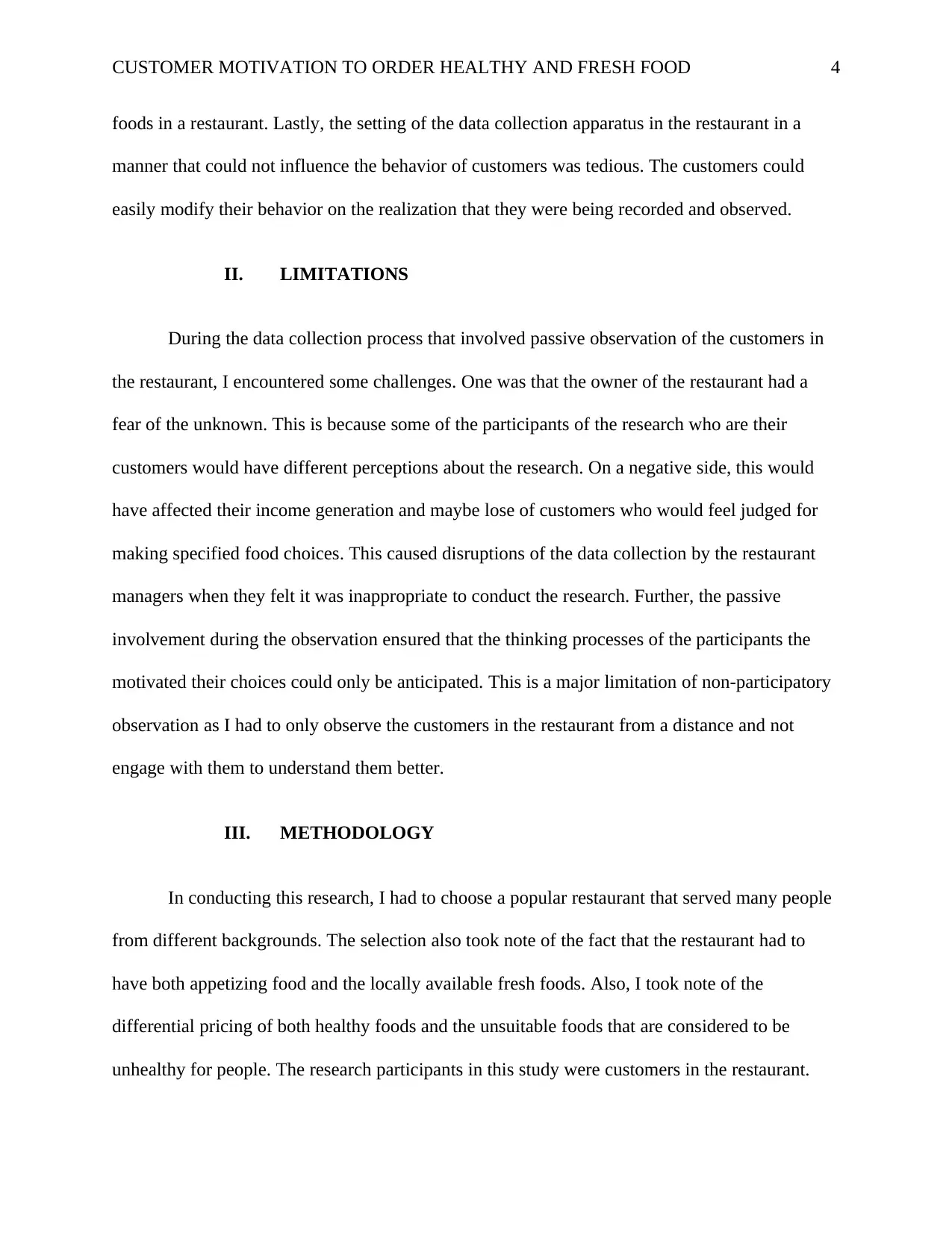
CUSTOMER MOTIVATION TO ORDER HEALTHY AND FRESH FOOD 4
foods in a restaurant. Lastly, the setting of the data collection apparatus in the restaurant in a
manner that could not influence the behavior of customers was tedious. The customers could
easily modify their behavior on the realization that they were being recorded and observed.
II. LIMITATIONS
During the data collection process that involved passive observation of the customers in
the restaurant, I encountered some challenges. One was that the owner of the restaurant had a
fear of the unknown. This is because some of the participants of the research who are their
customers would have different perceptions about the research. On a negative side, this would
have affected their income generation and maybe lose of customers who would feel judged for
making specified food choices. This caused disruptions of the data collection by the restaurant
managers when they felt it was inappropriate to conduct the research. Further, the passive
involvement during the observation ensured that the thinking processes of the participants the
motivated their choices could only be anticipated. This is a major limitation of non-participatory
observation as I had to only observe the customers in the restaurant from a distance and not
engage with them to understand them better.
III. METHODOLOGY
In conducting this research, I had to choose a popular restaurant that served many people
from different backgrounds. The selection also took note of the fact that the restaurant had to
have both appetizing food and the locally available fresh foods. Also, I took note of the
differential pricing of both healthy foods and the unsuitable foods that are considered to be
unhealthy for people. The research participants in this study were customers in the restaurant.
foods in a restaurant. Lastly, the setting of the data collection apparatus in the restaurant in a
manner that could not influence the behavior of customers was tedious. The customers could
easily modify their behavior on the realization that they were being recorded and observed.
II. LIMITATIONS
During the data collection process that involved passive observation of the customers in
the restaurant, I encountered some challenges. One was that the owner of the restaurant had a
fear of the unknown. This is because some of the participants of the research who are their
customers would have different perceptions about the research. On a negative side, this would
have affected their income generation and maybe lose of customers who would feel judged for
making specified food choices. This caused disruptions of the data collection by the restaurant
managers when they felt it was inappropriate to conduct the research. Further, the passive
involvement during the observation ensured that the thinking processes of the participants the
motivated their choices could only be anticipated. This is a major limitation of non-participatory
observation as I had to only observe the customers in the restaurant from a distance and not
engage with them to understand them better.
III. METHODOLOGY
In conducting this research, I had to choose a popular restaurant that served many people
from different backgrounds. The selection also took note of the fact that the restaurant had to
have both appetizing food and the locally available fresh foods. Also, I took note of the
differential pricing of both healthy foods and the unsuitable foods that are considered to be
unhealthy for people. The research participants in this study were customers in the restaurant.
Paraphrase This Document
Need a fresh take? Get an instant paraphrase of this document with our AI Paraphraser
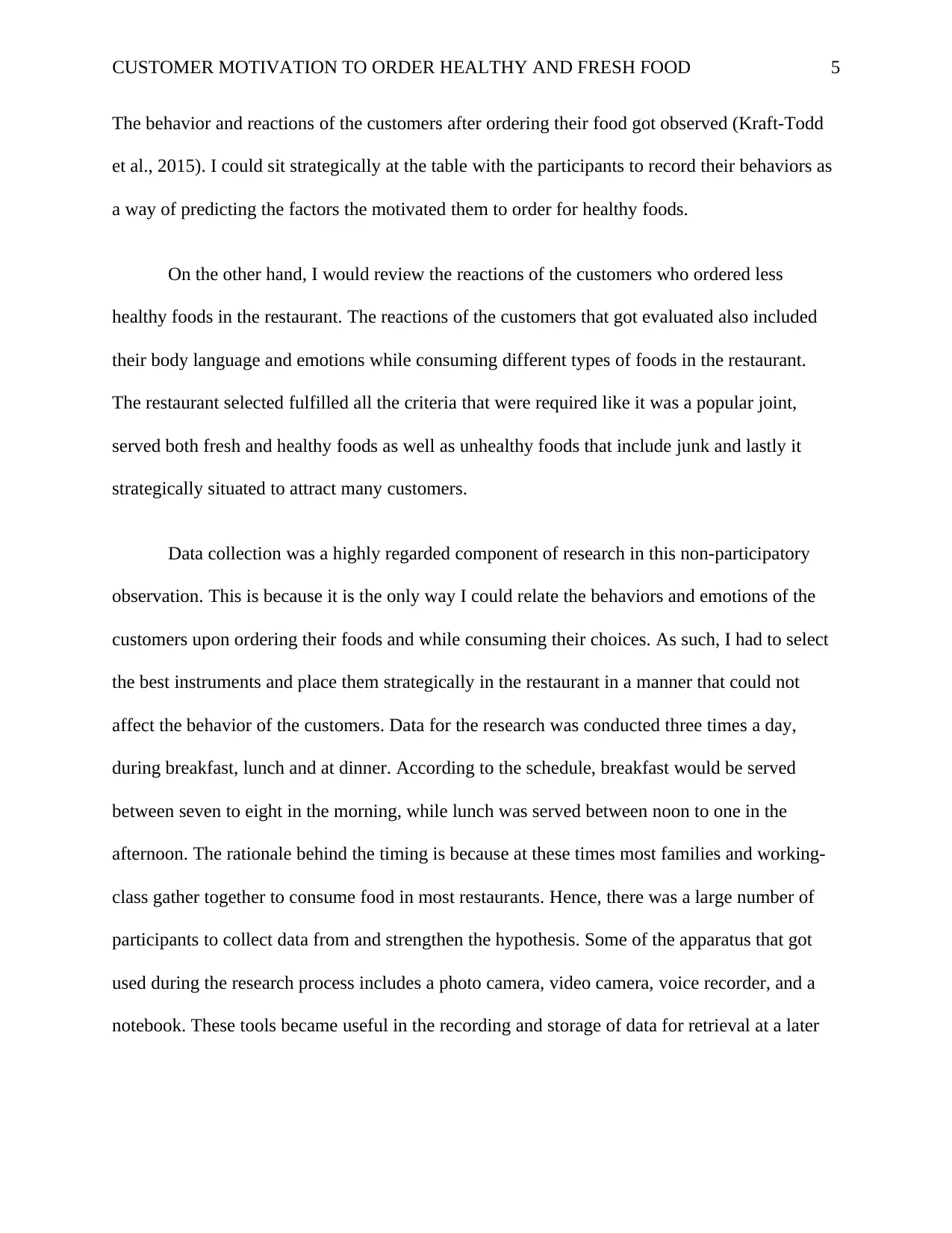
CUSTOMER MOTIVATION TO ORDER HEALTHY AND FRESH FOOD 5
The behavior and reactions of the customers after ordering their food got observed (Kraft-Todd
et al., 2015). I could sit strategically at the table with the participants to record their behaviors as
a way of predicting the factors the motivated them to order for healthy foods.
On the other hand, I would review the reactions of the customers who ordered less
healthy foods in the restaurant. The reactions of the customers that got evaluated also included
their body language and emotions while consuming different types of foods in the restaurant.
The restaurant selected fulfilled all the criteria that were required like it was a popular joint,
served both fresh and healthy foods as well as unhealthy foods that include junk and lastly it
strategically situated to attract many customers.
Data collection was a highly regarded component of research in this non-participatory
observation. This is because it is the only way I could relate the behaviors and emotions of the
customers upon ordering their foods and while consuming their choices. As such, I had to select
the best instruments and place them strategically in the restaurant in a manner that could not
affect the behavior of the customers. Data for the research was conducted three times a day,
during breakfast, lunch and at dinner. According to the schedule, breakfast would be served
between seven to eight in the morning, while lunch was served between noon to one in the
afternoon. The rationale behind the timing is because at these times most families and working-
class gather together to consume food in most restaurants. Hence, there was a large number of
participants to collect data from and strengthen the hypothesis. Some of the apparatus that got
used during the research process includes a photo camera, video camera, voice recorder, and a
notebook. These tools became useful in the recording and storage of data for retrieval at a later
The behavior and reactions of the customers after ordering their food got observed (Kraft-Todd
et al., 2015). I could sit strategically at the table with the participants to record their behaviors as
a way of predicting the factors the motivated them to order for healthy foods.
On the other hand, I would review the reactions of the customers who ordered less
healthy foods in the restaurant. The reactions of the customers that got evaluated also included
their body language and emotions while consuming different types of foods in the restaurant.
The restaurant selected fulfilled all the criteria that were required like it was a popular joint,
served both fresh and healthy foods as well as unhealthy foods that include junk and lastly it
strategically situated to attract many customers.
Data collection was a highly regarded component of research in this non-participatory
observation. This is because it is the only way I could relate the behaviors and emotions of the
customers upon ordering their foods and while consuming their choices. As such, I had to select
the best instruments and place them strategically in the restaurant in a manner that could not
affect the behavior of the customers. Data for the research was conducted three times a day,
during breakfast, lunch and at dinner. According to the schedule, breakfast would be served
between seven to eight in the morning, while lunch was served between noon to one in the
afternoon. The rationale behind the timing is because at these times most families and working-
class gather together to consume food in most restaurants. Hence, there was a large number of
participants to collect data from and strengthen the hypothesis. Some of the apparatus that got
used during the research process includes a photo camera, video camera, voice recorder, and a
notebook. These tools became useful in the recording and storage of data for retrieval at a later
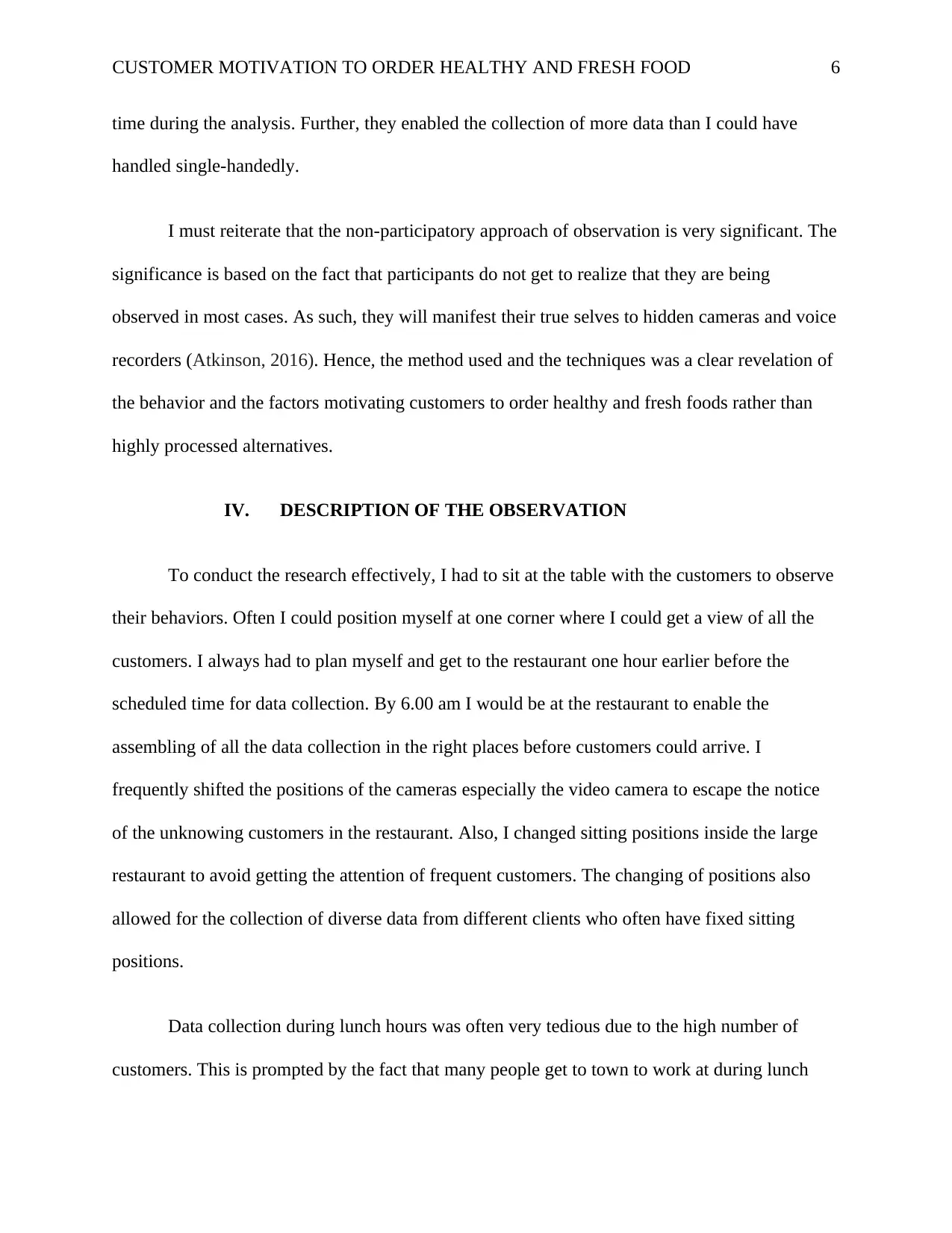
CUSTOMER MOTIVATION TO ORDER HEALTHY AND FRESH FOOD 6
time during the analysis. Further, they enabled the collection of more data than I could have
handled single-handedly.
I must reiterate that the non-participatory approach of observation is very significant. The
significance is based on the fact that participants do not get to realize that they are being
observed in most cases. As such, they will manifest their true selves to hidden cameras and voice
recorders (Atkinson, 2016). Hence, the method used and the techniques was a clear revelation of
the behavior and the factors motivating customers to order healthy and fresh foods rather than
highly processed alternatives.
IV. DESCRIPTION OF THE OBSERVATION
To conduct the research effectively, I had to sit at the table with the customers to observe
their behaviors. Often I could position myself at one corner where I could get a view of all the
customers. I always had to plan myself and get to the restaurant one hour earlier before the
scheduled time for data collection. By 6.00 am I would be at the restaurant to enable the
assembling of all the data collection in the right places before customers could arrive. I
frequently shifted the positions of the cameras especially the video camera to escape the notice
of the unknowing customers in the restaurant. Also, I changed sitting positions inside the large
restaurant to avoid getting the attention of frequent customers. The changing of positions also
allowed for the collection of diverse data from different clients who often have fixed sitting
positions.
Data collection during lunch hours was often very tedious due to the high number of
customers. This is prompted by the fact that many people get to town to work at during lunch
time during the analysis. Further, they enabled the collection of more data than I could have
handled single-handedly.
I must reiterate that the non-participatory approach of observation is very significant. The
significance is based on the fact that participants do not get to realize that they are being
observed in most cases. As such, they will manifest their true selves to hidden cameras and voice
recorders (Atkinson, 2016). Hence, the method used and the techniques was a clear revelation of
the behavior and the factors motivating customers to order healthy and fresh foods rather than
highly processed alternatives.
IV. DESCRIPTION OF THE OBSERVATION
To conduct the research effectively, I had to sit at the table with the customers to observe
their behaviors. Often I could position myself at one corner where I could get a view of all the
customers. I always had to plan myself and get to the restaurant one hour earlier before the
scheduled time for data collection. By 6.00 am I would be at the restaurant to enable the
assembling of all the data collection in the right places before customers could arrive. I
frequently shifted the positions of the cameras especially the video camera to escape the notice
of the unknowing customers in the restaurant. Also, I changed sitting positions inside the large
restaurant to avoid getting the attention of frequent customers. The changing of positions also
allowed for the collection of diverse data from different clients who often have fixed sitting
positions.
Data collection during lunch hours was often very tedious due to the high number of
customers. This is prompted by the fact that many people get to town to work at during lunch
⊘ This is a preview!⊘
Do you want full access?
Subscribe today to unlock all pages.

Trusted by 1+ million students worldwide
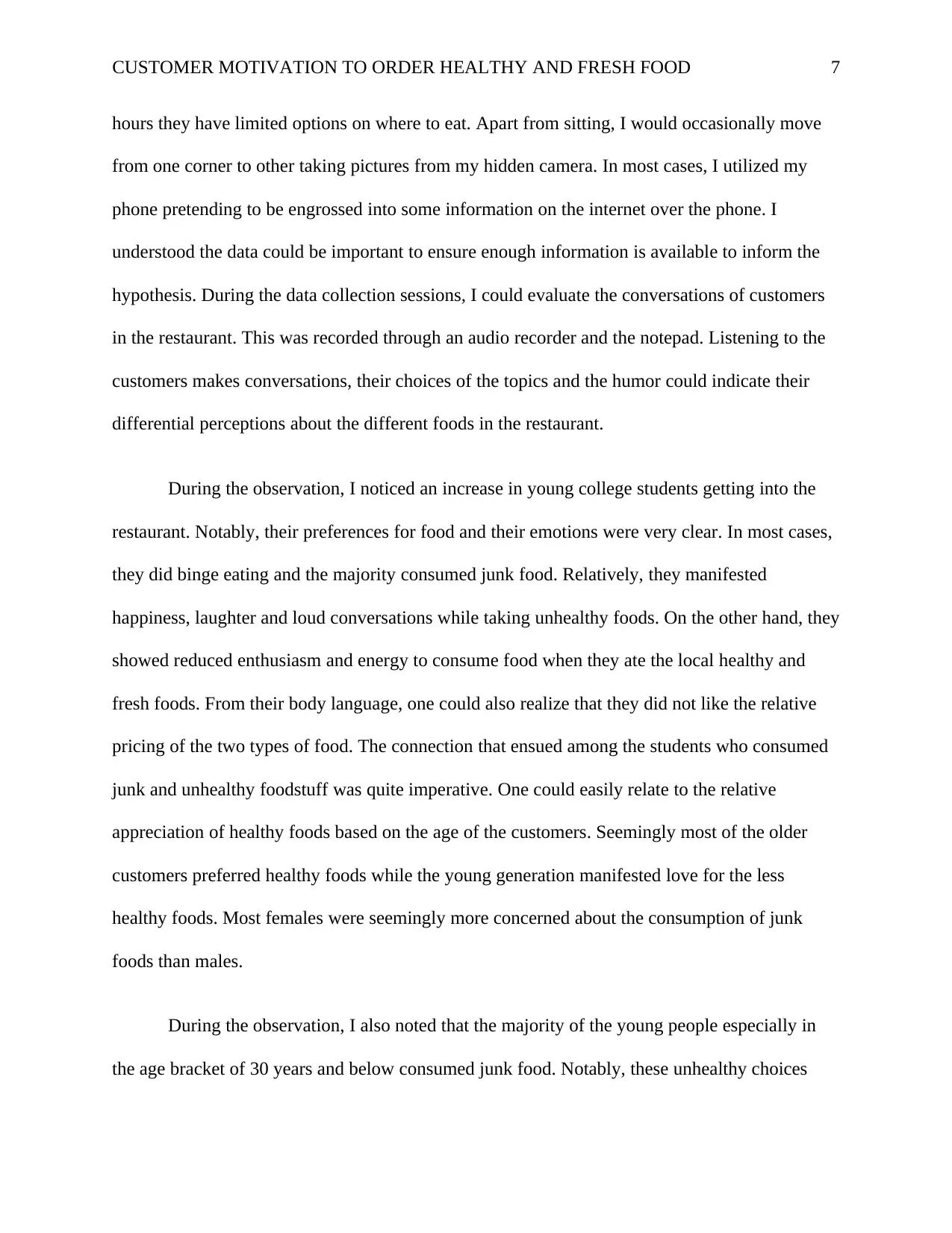
CUSTOMER MOTIVATION TO ORDER HEALTHY AND FRESH FOOD 7
hours they have limited options on where to eat. Apart from sitting, I would occasionally move
from one corner to other taking pictures from my hidden camera. In most cases, I utilized my
phone pretending to be engrossed into some information on the internet over the phone. I
understood the data could be important to ensure enough information is available to inform the
hypothesis. During the data collection sessions, I could evaluate the conversations of customers
in the restaurant. This was recorded through an audio recorder and the notepad. Listening to the
customers makes conversations, their choices of the topics and the humor could indicate their
differential perceptions about the different foods in the restaurant.
During the observation, I noticed an increase in young college students getting into the
restaurant. Notably, their preferences for food and their emotions were very clear. In most cases,
they did binge eating and the majority consumed junk food. Relatively, they manifested
happiness, laughter and loud conversations while taking unhealthy foods. On the other hand, they
showed reduced enthusiasm and energy to consume food when they ate the local healthy and
fresh foods. From their body language, one could also realize that they did not like the relative
pricing of the two types of food. The connection that ensued among the students who consumed
junk and unhealthy foodstuff was quite imperative. One could easily relate to the relative
appreciation of healthy foods based on the age of the customers. Seemingly most of the older
customers preferred healthy foods while the young generation manifested love for the less
healthy foods. Most females were seemingly more concerned about the consumption of junk
foods than males.
During the observation, I also noted that the majority of the young people especially in
the age bracket of 30 years and below consumed junk food. Notably, these unhealthy choices
hours they have limited options on where to eat. Apart from sitting, I would occasionally move
from one corner to other taking pictures from my hidden camera. In most cases, I utilized my
phone pretending to be engrossed into some information on the internet over the phone. I
understood the data could be important to ensure enough information is available to inform the
hypothesis. During the data collection sessions, I could evaluate the conversations of customers
in the restaurant. This was recorded through an audio recorder and the notepad. Listening to the
customers makes conversations, their choices of the topics and the humor could indicate their
differential perceptions about the different foods in the restaurant.
During the observation, I noticed an increase in young college students getting into the
restaurant. Notably, their preferences for food and their emotions were very clear. In most cases,
they did binge eating and the majority consumed junk food. Relatively, they manifested
happiness, laughter and loud conversations while taking unhealthy foods. On the other hand, they
showed reduced enthusiasm and energy to consume food when they ate the local healthy and
fresh foods. From their body language, one could also realize that they did not like the relative
pricing of the two types of food. The connection that ensued among the students who consumed
junk and unhealthy foodstuff was quite imperative. One could easily relate to the relative
appreciation of healthy foods based on the age of the customers. Seemingly most of the older
customers preferred healthy foods while the young generation manifested love for the less
healthy foods. Most females were seemingly more concerned about the consumption of junk
foods than males.
During the observation, I also noted that the majority of the young people especially in
the age bracket of 30 years and below consumed junk food. Notably, these unhealthy choices
Paraphrase This Document
Need a fresh take? Get an instant paraphrase of this document with our AI Paraphraser
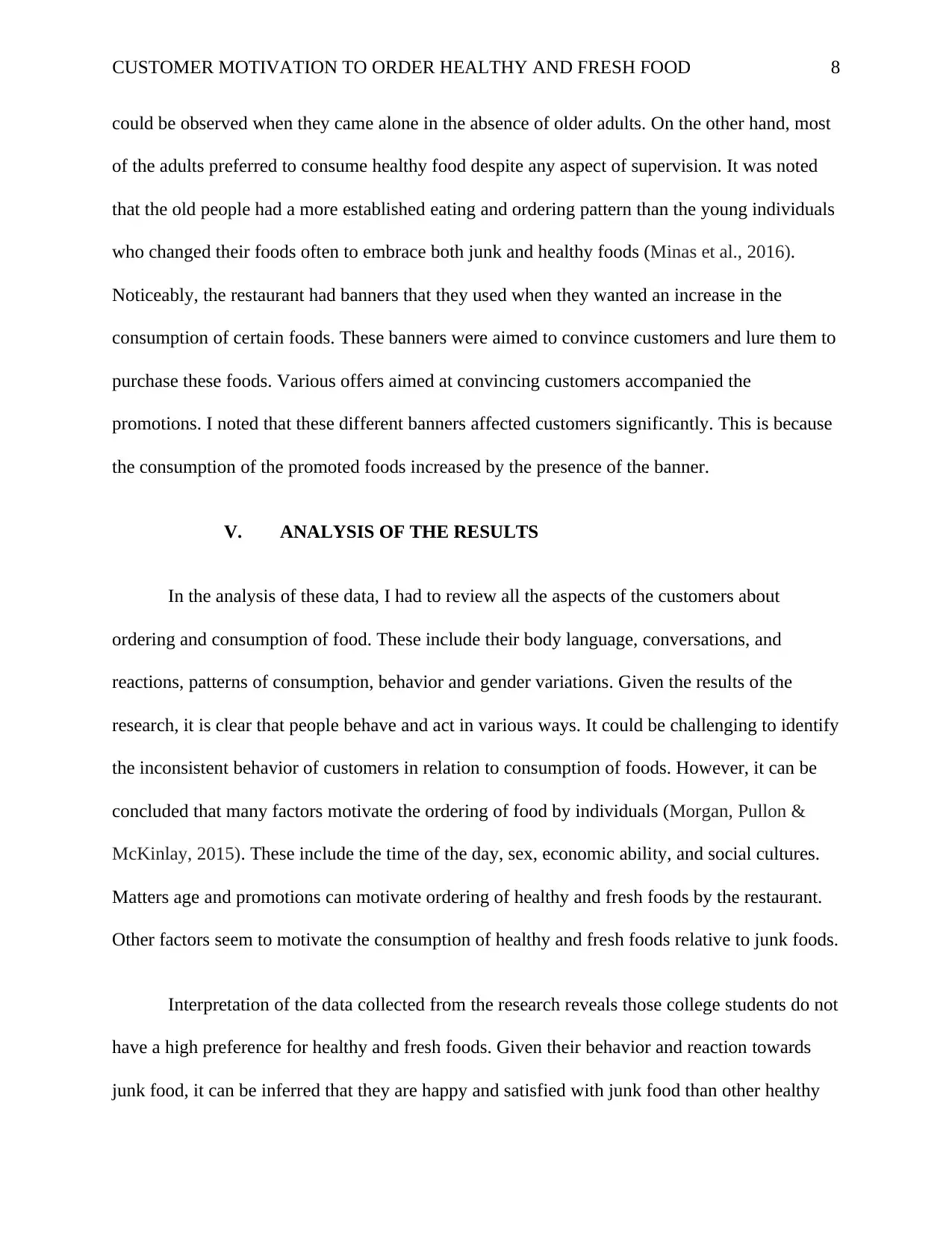
CUSTOMER MOTIVATION TO ORDER HEALTHY AND FRESH FOOD 8
could be observed when they came alone in the absence of older adults. On the other hand, most
of the adults preferred to consume healthy food despite any aspect of supervision. It was noted
that the old people had a more established eating and ordering pattern than the young individuals
who changed their foods often to embrace both junk and healthy foods (Minas et al., 2016).
Noticeably, the restaurant had banners that they used when they wanted an increase in the
consumption of certain foods. These banners were aimed to convince customers and lure them to
purchase these foods. Various offers aimed at convincing customers accompanied the
promotions. I noted that these different banners affected customers significantly. This is because
the consumption of the promoted foods increased by the presence of the banner.
V. ANALYSIS OF THE RESULTS
In the analysis of these data, I had to review all the aspects of the customers about
ordering and consumption of food. These include their body language, conversations, and
reactions, patterns of consumption, behavior and gender variations. Given the results of the
research, it is clear that people behave and act in various ways. It could be challenging to identify
the inconsistent behavior of customers in relation to consumption of foods. However, it can be
concluded that many factors motivate the ordering of food by individuals (Morgan, Pullon &
McKinlay, 2015). These include the time of the day, sex, economic ability, and social cultures.
Matters age and promotions can motivate ordering of healthy and fresh foods by the restaurant.
Other factors seem to motivate the consumption of healthy and fresh foods relative to junk foods.
Interpretation of the data collected from the research reveals those college students do not
have a high preference for healthy and fresh foods. Given their behavior and reaction towards
junk food, it can be inferred that they are happy and satisfied with junk food than other healthy
could be observed when they came alone in the absence of older adults. On the other hand, most
of the adults preferred to consume healthy food despite any aspect of supervision. It was noted
that the old people had a more established eating and ordering pattern than the young individuals
who changed their foods often to embrace both junk and healthy foods (Minas et al., 2016).
Noticeably, the restaurant had banners that they used when they wanted an increase in the
consumption of certain foods. These banners were aimed to convince customers and lure them to
purchase these foods. Various offers aimed at convincing customers accompanied the
promotions. I noted that these different banners affected customers significantly. This is because
the consumption of the promoted foods increased by the presence of the banner.
V. ANALYSIS OF THE RESULTS
In the analysis of these data, I had to review all the aspects of the customers about
ordering and consumption of food. These include their body language, conversations, and
reactions, patterns of consumption, behavior and gender variations. Given the results of the
research, it is clear that people behave and act in various ways. It could be challenging to identify
the inconsistent behavior of customers in relation to consumption of foods. However, it can be
concluded that many factors motivate the ordering of food by individuals (Morgan, Pullon &
McKinlay, 2015). These include the time of the day, sex, economic ability, and social cultures.
Matters age and promotions can motivate ordering of healthy and fresh foods by the restaurant.
Other factors seem to motivate the consumption of healthy and fresh foods relative to junk foods.
Interpretation of the data collected from the research reveals those college students do not
have a high preference for healthy and fresh foods. Given their behavior and reaction towards
junk food, it can be inferred that they are happy and satisfied with junk food than other healthy
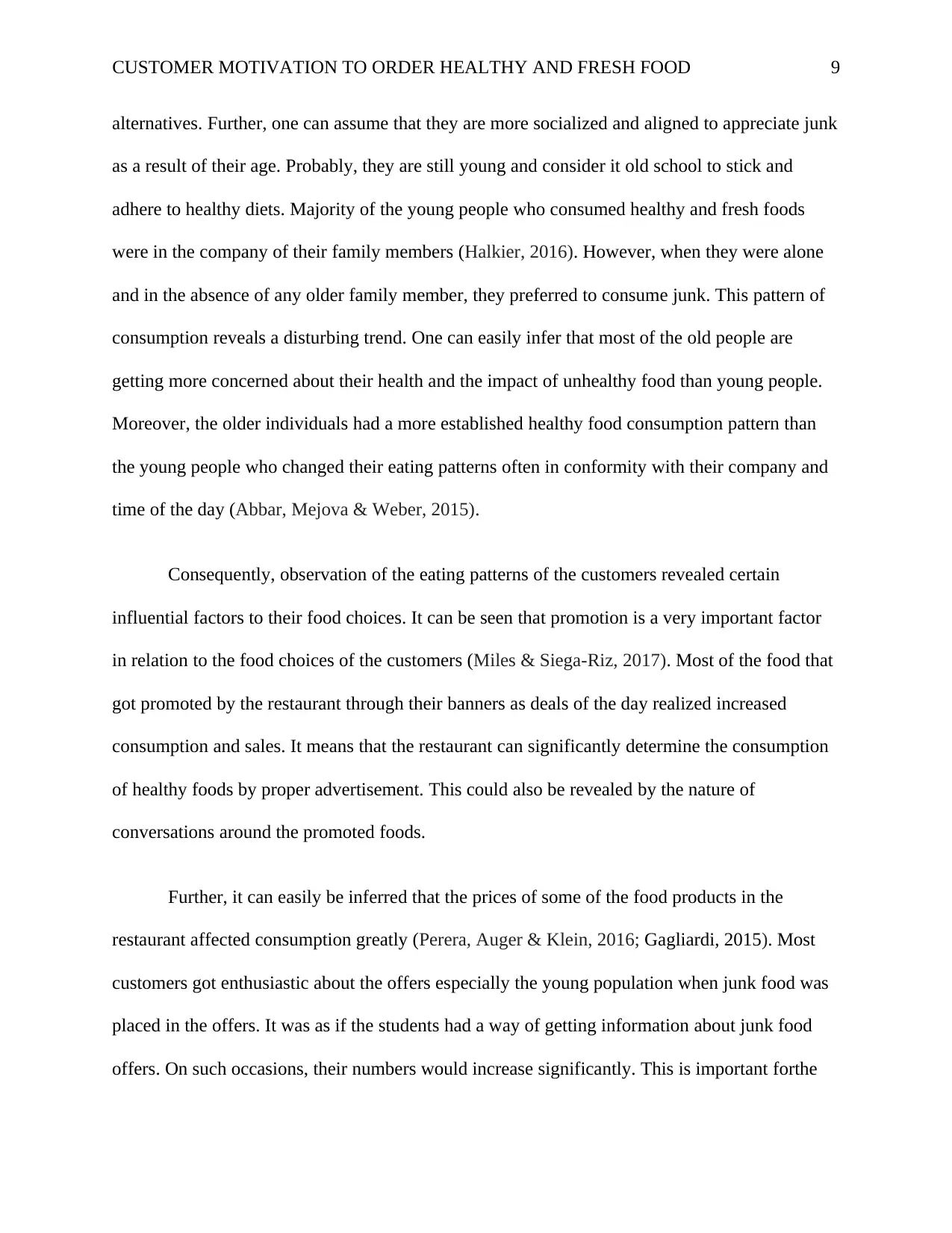
CUSTOMER MOTIVATION TO ORDER HEALTHY AND FRESH FOOD 9
alternatives. Further, one can assume that they are more socialized and aligned to appreciate junk
as a result of their age. Probably, they are still young and consider it old school to stick and
adhere to healthy diets. Majority of the young people who consumed healthy and fresh foods
were in the company of their family members (Halkier, 2016). However, when they were alone
and in the absence of any older family member, they preferred to consume junk. This pattern of
consumption reveals a disturbing trend. One can easily infer that most of the old people are
getting more concerned about their health and the impact of unhealthy food than young people.
Moreover, the older individuals had a more established healthy food consumption pattern than
the young people who changed their eating patterns often in conformity with their company and
time of the day (Abbar, Mejova & Weber, 2015).
Consequently, observation of the eating patterns of the customers revealed certain
influential factors to their food choices. It can be seen that promotion is a very important factor
in relation to the food choices of the customers (Miles & Siega-Riz, 2017). Most of the food that
got promoted by the restaurant through their banners as deals of the day realized increased
consumption and sales. It means that the restaurant can significantly determine the consumption
of healthy foods by proper advertisement. This could also be revealed by the nature of
conversations around the promoted foods.
Further, it can easily be inferred that the prices of some of the food products in the
restaurant affected consumption greatly (Perera, Auger & Klein, 2016; Gagliardi, 2015). Most
customers got enthusiastic about the offers especially the young population when junk food was
placed in the offers. It was as if the students had a way of getting information about junk food
offers. On such occasions, their numbers would increase significantly. This is important forthe
alternatives. Further, one can assume that they are more socialized and aligned to appreciate junk
as a result of their age. Probably, they are still young and consider it old school to stick and
adhere to healthy diets. Majority of the young people who consumed healthy and fresh foods
were in the company of their family members (Halkier, 2016). However, when they were alone
and in the absence of any older family member, they preferred to consume junk. This pattern of
consumption reveals a disturbing trend. One can easily infer that most of the old people are
getting more concerned about their health and the impact of unhealthy food than young people.
Moreover, the older individuals had a more established healthy food consumption pattern than
the young people who changed their eating patterns often in conformity with their company and
time of the day (Abbar, Mejova & Weber, 2015).
Consequently, observation of the eating patterns of the customers revealed certain
influential factors to their food choices. It can be seen that promotion is a very important factor
in relation to the food choices of the customers (Miles & Siega-Riz, 2017). Most of the food that
got promoted by the restaurant through their banners as deals of the day realized increased
consumption and sales. It means that the restaurant can significantly determine the consumption
of healthy foods by proper advertisement. This could also be revealed by the nature of
conversations around the promoted foods.
Further, it can easily be inferred that the prices of some of the food products in the
restaurant affected consumption greatly (Perera, Auger & Klein, 2016; Gagliardi, 2015). Most
customers got enthusiastic about the offers especially the young population when junk food was
placed in the offers. It was as if the students had a way of getting information about junk food
offers. On such occasions, their numbers would increase significantly. This is important forthe
⊘ This is a preview!⊘
Do you want full access?
Subscribe today to unlock all pages.

Trusted by 1+ million students worldwide
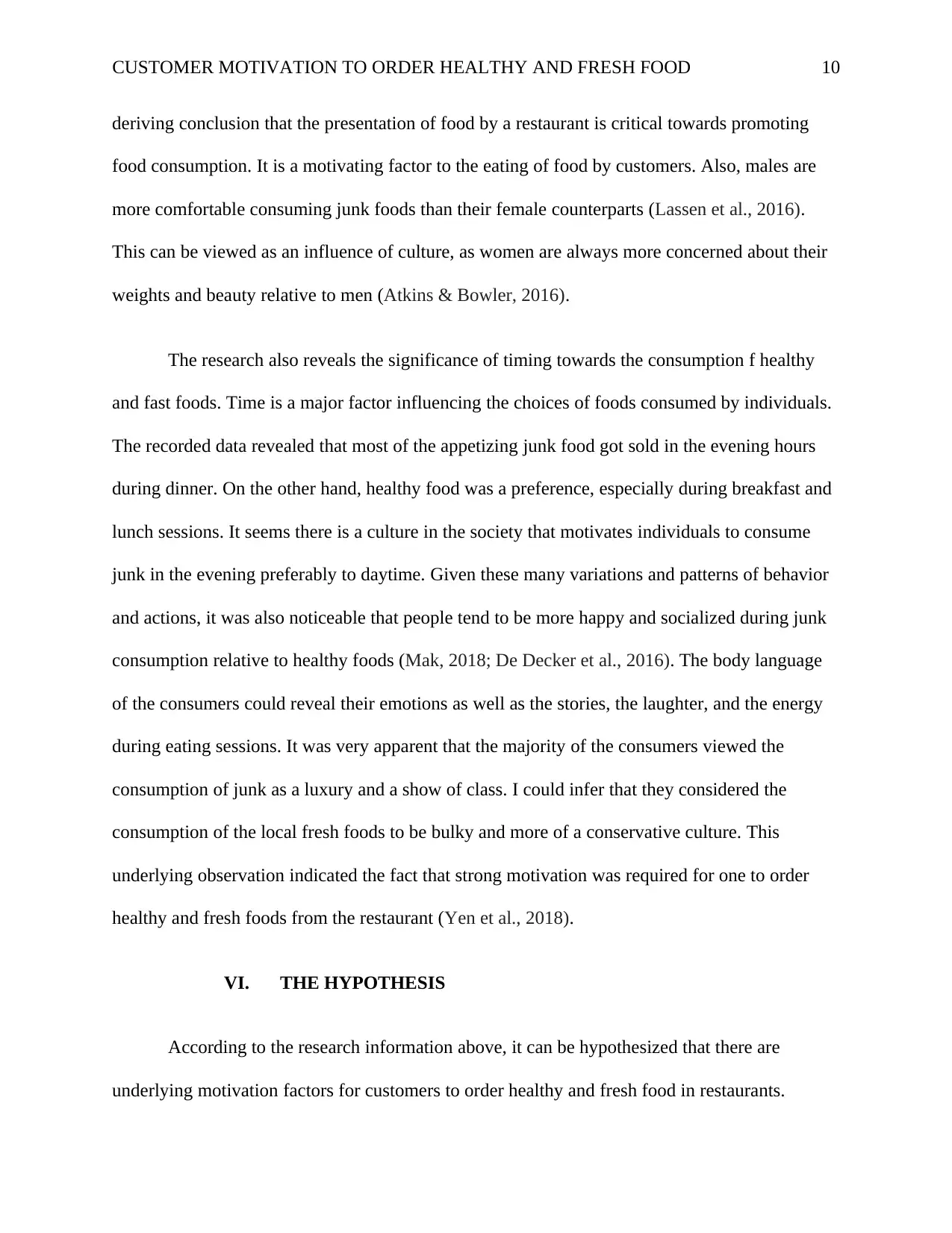
CUSTOMER MOTIVATION TO ORDER HEALTHY AND FRESH FOOD 10
deriving conclusion that the presentation of food by a restaurant is critical towards promoting
food consumption. It is a motivating factor to the eating of food by customers. Also, males are
more comfortable consuming junk foods than their female counterparts (Lassen et al., 2016).
This can be viewed as an influence of culture, as women are always more concerned about their
weights and beauty relative to men (Atkins & Bowler, 2016).
The research also reveals the significance of timing towards the consumption f healthy
and fast foods. Time is a major factor influencing the choices of foods consumed by individuals.
The recorded data revealed that most of the appetizing junk food got sold in the evening hours
during dinner. On the other hand, healthy food was a preference, especially during breakfast and
lunch sessions. It seems there is a culture in the society that motivates individuals to consume
junk in the evening preferably to daytime. Given these many variations and patterns of behavior
and actions, it was also noticeable that people tend to be more happy and socialized during junk
consumption relative to healthy foods (Mak, 2018; De Decker et al., 2016). The body language
of the consumers could reveal their emotions as well as the stories, the laughter, and the energy
during eating sessions. It was very apparent that the majority of the consumers viewed the
consumption of junk as a luxury and a show of class. I could infer that they considered the
consumption of the local fresh foods to be bulky and more of a conservative culture. This
underlying observation indicated the fact that strong motivation was required for one to order
healthy and fresh foods from the restaurant (Yen et al., 2018).
VI. THE HYPOTHESIS
According to the research information above, it can be hypothesized that there are
underlying motivation factors for customers to order healthy and fresh food in restaurants.
deriving conclusion that the presentation of food by a restaurant is critical towards promoting
food consumption. It is a motivating factor to the eating of food by customers. Also, males are
more comfortable consuming junk foods than their female counterparts (Lassen et al., 2016).
This can be viewed as an influence of culture, as women are always more concerned about their
weights and beauty relative to men (Atkins & Bowler, 2016).
The research also reveals the significance of timing towards the consumption f healthy
and fast foods. Time is a major factor influencing the choices of foods consumed by individuals.
The recorded data revealed that most of the appetizing junk food got sold in the evening hours
during dinner. On the other hand, healthy food was a preference, especially during breakfast and
lunch sessions. It seems there is a culture in the society that motivates individuals to consume
junk in the evening preferably to daytime. Given these many variations and patterns of behavior
and actions, it was also noticeable that people tend to be more happy and socialized during junk
consumption relative to healthy foods (Mak, 2018; De Decker et al., 2016). The body language
of the consumers could reveal their emotions as well as the stories, the laughter, and the energy
during eating sessions. It was very apparent that the majority of the consumers viewed the
consumption of junk as a luxury and a show of class. I could infer that they considered the
consumption of the local fresh foods to be bulky and more of a conservative culture. This
underlying observation indicated the fact that strong motivation was required for one to order
healthy and fresh foods from the restaurant (Yen et al., 2018).
VI. THE HYPOTHESIS
According to the research information above, it can be hypothesized that there are
underlying motivation factors for customers to order healthy and fresh food in restaurants.
Paraphrase This Document
Need a fresh take? Get an instant paraphrase of this document with our AI Paraphraser
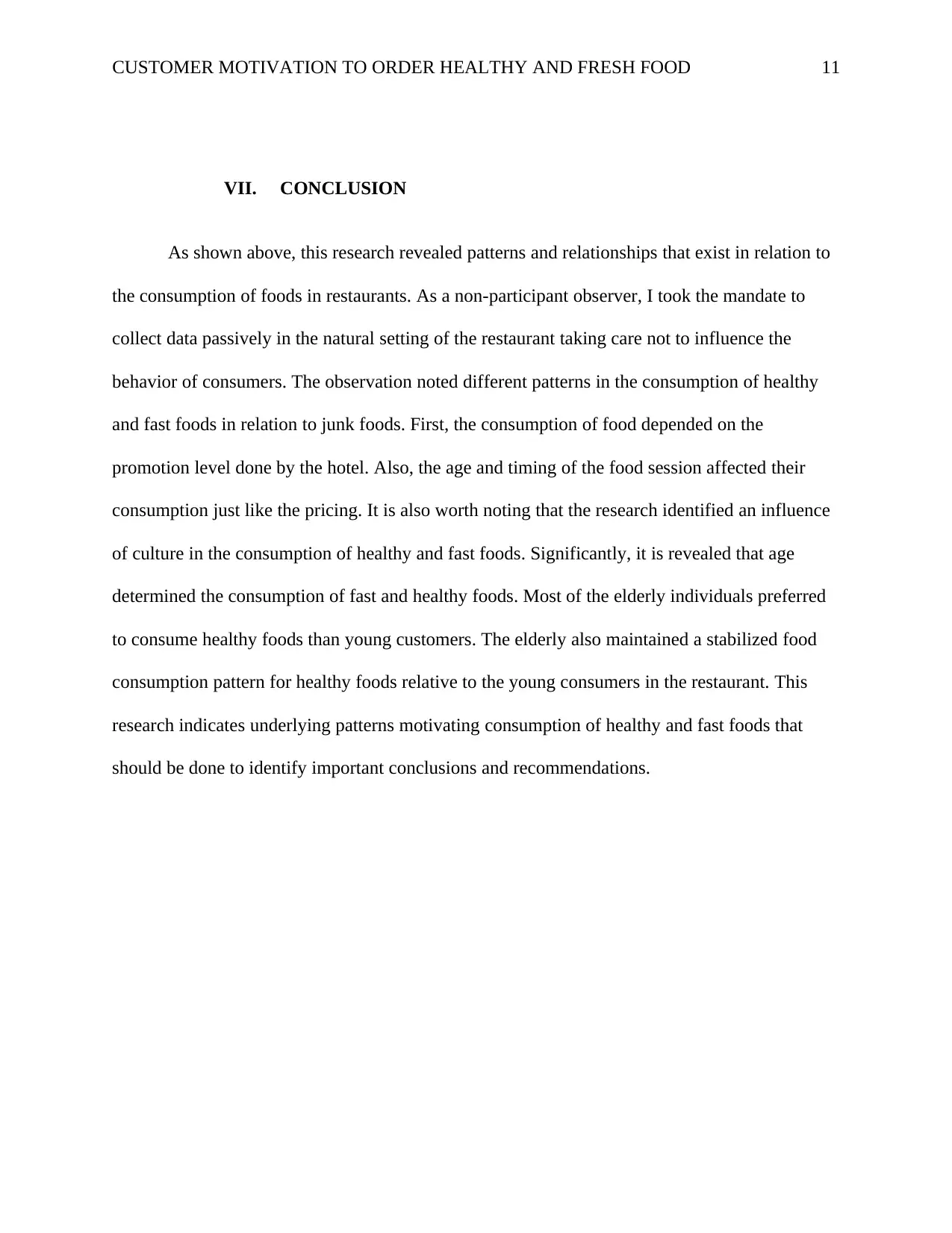
CUSTOMER MOTIVATION TO ORDER HEALTHY AND FRESH FOOD 11
VII. CONCLUSION
As shown above, this research revealed patterns and relationships that exist in relation to
the consumption of foods in restaurants. As a non-participant observer, I took the mandate to
collect data passively in the natural setting of the restaurant taking care not to influence the
behavior of consumers. The observation noted different patterns in the consumption of healthy
and fast foods in relation to junk foods. First, the consumption of food depended on the
promotion level done by the hotel. Also, the age and timing of the food session affected their
consumption just like the pricing. It is also worth noting that the research identified an influence
of culture in the consumption of healthy and fast foods. Significantly, it is revealed that age
determined the consumption of fast and healthy foods. Most of the elderly individuals preferred
to consume healthy foods than young customers. The elderly also maintained a stabilized food
consumption pattern for healthy foods relative to the young consumers in the restaurant. This
research indicates underlying patterns motivating consumption of healthy and fast foods that
should be done to identify important conclusions and recommendations.
VII. CONCLUSION
As shown above, this research revealed patterns and relationships that exist in relation to
the consumption of foods in restaurants. As a non-participant observer, I took the mandate to
collect data passively in the natural setting of the restaurant taking care not to influence the
behavior of consumers. The observation noted different patterns in the consumption of healthy
and fast foods in relation to junk foods. First, the consumption of food depended on the
promotion level done by the hotel. Also, the age and timing of the food session affected their
consumption just like the pricing. It is also worth noting that the research identified an influence
of culture in the consumption of healthy and fast foods. Significantly, it is revealed that age
determined the consumption of fast and healthy foods. Most of the elderly individuals preferred
to consume healthy foods than young customers. The elderly also maintained a stabilized food
consumption pattern for healthy foods relative to the young consumers in the restaurant. This
research indicates underlying patterns motivating consumption of healthy and fast foods that
should be done to identify important conclusions and recommendations.
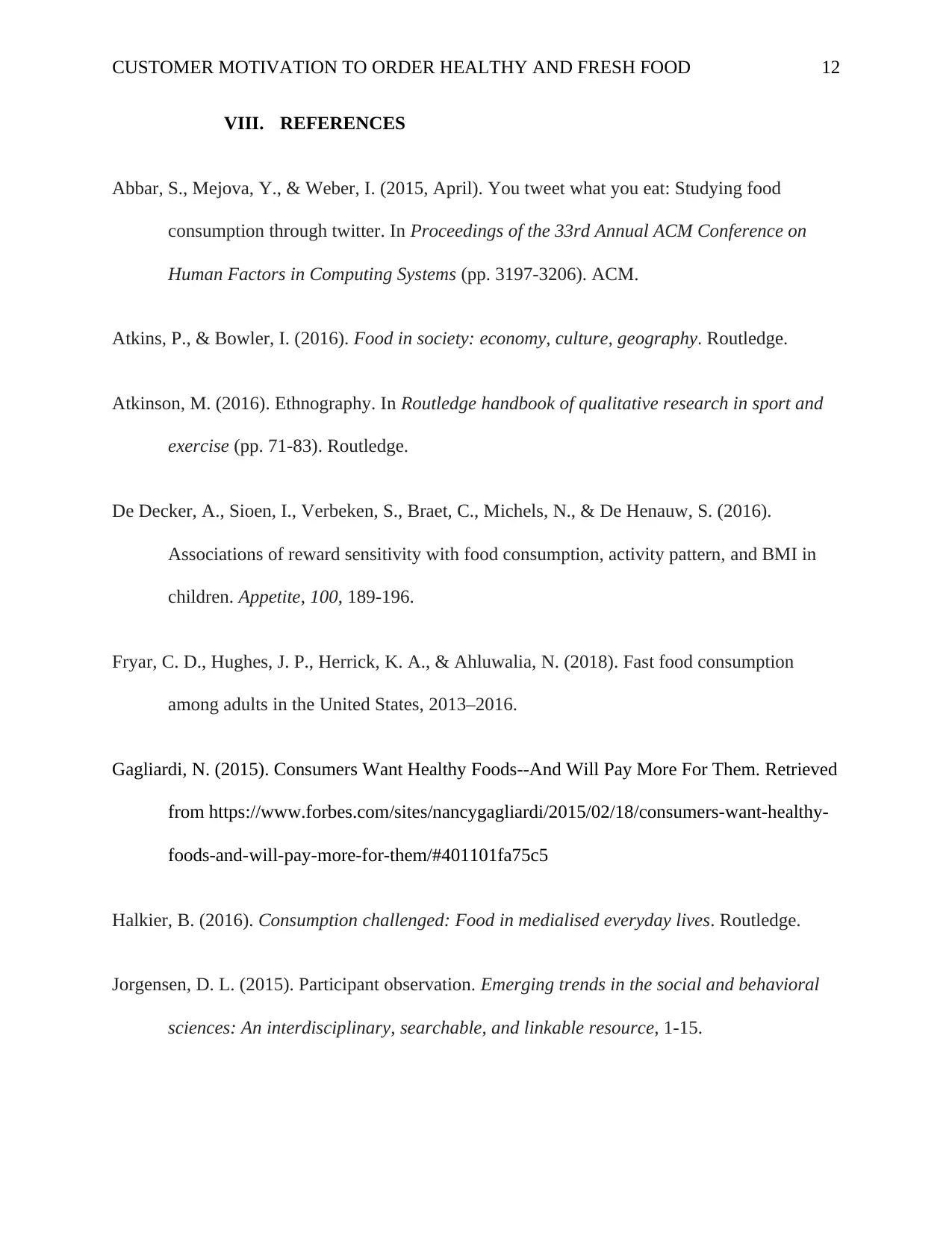
CUSTOMER MOTIVATION TO ORDER HEALTHY AND FRESH FOOD 12
VIII. REFERENCES
Abbar, S., Mejova, Y., & Weber, I. (2015, April). You tweet what you eat: Studying food
consumption through twitter. In Proceedings of the 33rd Annual ACM Conference on
Human Factors in Computing Systems (pp. 3197-3206). ACM.
Atkins, P., & Bowler, I. (2016). Food in society: economy, culture, geography. Routledge.
Atkinson, M. (2016). Ethnography. In Routledge handbook of qualitative research in sport and
exercise (pp. 71-83). Routledge.
De Decker, A., Sioen, I., Verbeken, S., Braet, C., Michels, N., & De Henauw, S. (2016).
Associations of reward sensitivity with food consumption, activity pattern, and BMI in
children. Appetite, 100, 189-196.
Fryar, C. D., Hughes, J. P., Herrick, K. A., & Ahluwalia, N. (2018). Fast food consumption
among adults in the United States, 2013–2016.
Gagliardi, N. (2015). Consumers Want Healthy Foods--And Will Pay More For Them. Retrieved
from https://www.forbes.com/sites/nancygagliardi/2015/02/18/consumers-want-healthy-
foods-and-will-pay-more-for-them/#401101fa75c5
Halkier, B. (2016). Consumption challenged: Food in medialised everyday lives. Routledge.
Jorgensen, D. L. (2015). Participant observation. Emerging trends in the social and behavioral
sciences: An interdisciplinary, searchable, and linkable resource, 1-15.
VIII. REFERENCES
Abbar, S., Mejova, Y., & Weber, I. (2015, April). You tweet what you eat: Studying food
consumption through twitter. In Proceedings of the 33rd Annual ACM Conference on
Human Factors in Computing Systems (pp. 3197-3206). ACM.
Atkins, P., & Bowler, I. (2016). Food in society: economy, culture, geography. Routledge.
Atkinson, M. (2016). Ethnography. In Routledge handbook of qualitative research in sport and
exercise (pp. 71-83). Routledge.
De Decker, A., Sioen, I., Verbeken, S., Braet, C., Michels, N., & De Henauw, S. (2016).
Associations of reward sensitivity with food consumption, activity pattern, and BMI in
children. Appetite, 100, 189-196.
Fryar, C. D., Hughes, J. P., Herrick, K. A., & Ahluwalia, N. (2018). Fast food consumption
among adults in the United States, 2013–2016.
Gagliardi, N. (2015). Consumers Want Healthy Foods--And Will Pay More For Them. Retrieved
from https://www.forbes.com/sites/nancygagliardi/2015/02/18/consumers-want-healthy-
foods-and-will-pay-more-for-them/#401101fa75c5
Halkier, B. (2016). Consumption challenged: Food in medialised everyday lives. Routledge.
Jorgensen, D. L. (2015). Participant observation. Emerging trends in the social and behavioral
sciences: An interdisciplinary, searchable, and linkable resource, 1-15.
⊘ This is a preview!⊘
Do you want full access?
Subscribe today to unlock all pages.

Trusted by 1+ million students worldwide
1 out of 15
Related Documents
Your All-in-One AI-Powered Toolkit for Academic Success.
+13062052269
info@desklib.com
Available 24*7 on WhatsApp / Email
![[object Object]](/_next/static/media/star-bottom.7253800d.svg)
Unlock your academic potential
Copyright © 2020–2025 A2Z Services. All Rights Reserved. Developed and managed by ZUCOL.





